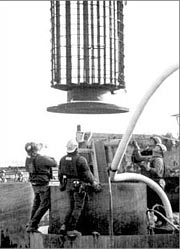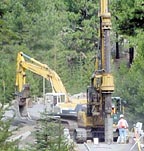
We talked to a few contractors in different parts of the country to get a sense of what's taking place in the foundation-drilling sector, and by all accounts, there's a great deal of going on.
Drilled shaft projects, in particular, are increasingly popular jobs for this market. "There's been a tremendous growth of drilled shaft work all around the country," reveals John Roma, vice president and general manager of New England Foundation Co. Inc., Quincy, Mass. For big loads, drilled shafts offer an enormous load-carrying capacity and they're economically attractive; in addition, they are scour-resistant for bridges, he says, outlining what has contributed to their increased use.
And such growth is likely to continue, Eric Reuther, president of Illini Drilled Foundations Inc., Danville, Ill., suggests: "I think you're going to see a lot of drilled shaft work in the bridges - DOTs are using them more and more all the time."
The deep, large-diameter holes required for drilled shaft projects are expected to get even bigger. With larger shafts and farther penetration into rock now more desirable, machines that can meet the challenge are needed. Unlike some other drilling markets, where the trend for drill rigs is a movement toward more compact, more powerful machines, it's just the opposite for drilled shaft work. "We're seeing bigger machines, more powerful machines, all the time," Roma explains. "The trend is for bigger holes, deeper holes, resulting in bigger machines that can drill deeper." Pile-top machines are being used more for drilled shaft projects, and currently, much of the new technology is coming out of Germany and Italy.
For quite some time, slurry drilling has been the method of choice to complete drilled shafts. Based on this trend, its frequent use could be expected to continue, especially for projects that require drilling deep below the ground water table.
In the next five years, however, according to Reuther, the industry should anticipate a decrease in slurry drilling with an increase in drilled casings. "That's going to come with emerging technologies and new equipment out there with the ability to install casing as we drill and eliminate the need for slurry drilling," he predicts, proposing drilled casings would offer higher quality control as well as a better feel for how shafts go in.

Managing Client Relationships
Contractors have found that foundation drilling is an evolving market. Much of the change is initiated by contractors having to deal with clients who are demanding more as well as how they're responding to client requests.Explaining one way the market's changing, Reuther describes that those doing drilled shaft caisson work now are having to adjust to accommodate the integrity testing that's occurring more frequently. "Quality control issues are becoming more important to the owner. Along with that, you actually get a change in technique to make sure you meet their quality assurance requirements," he notes.
Quality assurance inspections have become more standard. Typically, once drilled shafts are completed, clients may require non-destructive testing by an independent engineer to ensure the quality of the end product. Such testing can tack on time to the project, which also can be a problem. "The biggest challenge with industrial work is meeting the schedule. These guys will schedule these jobs to be done almost faster than they can be done," Reuther remarks.
Working to affect positive changes for the industry, the northeast chapter of the ADSC: The International Association of Foundation Drilling is taking steps to address concerns of both contractors and clients in that area. "We're trying to address constructability issues in joint meetings of the ADSC-Northeast chapter with representatives from the federal highway people and also the northeast states' geotechnical and structural people," explains Roma, who along with Martin McDermott, the president of this chapter, played an active role in organizing these meetings. "We're trying to meet with people to make it a more level playing field for both sides - so the owner doesn't get abused, nor does the contractor get abused."
Opening the lines of communication seems to be a main objective - making sure the parties involved engage important issues upfront and become aware of the challenges the other side faces. One of the constructability concerns is the flow of concrete through reinforcing cages, the design of which can sometimes impede concrete-flow and create problems for the contractors using them. "Sometimes the cages are so tight that the concrete won't flow through the cage," reveals Roma. "People design something on a piece of paper without having any field experience, and we're trying to address that. We're trying to mesh the proper concrete with the reinforcing steel cage."
In addition to improving the materials and equipment used, increasing knowledge-sharing and managing expectations also are focal points. Not having sufficient geotechnical information poses problems for foundation contractors who are expected to drill through difficult rock conditions without knowing what those conditions are. "Some states or people just label rock as rock without giving any information on the rock - what kind it is or the strength of it and so forth," he states. "We're trying to push provisions for obstructions." Because contractors can get through obstructions, they are expected to get through obstructions. But contractors can only base pricing on known or given information, so addressing and resolving this issue is a priority.
Between adjusting techniques to meet clients' quality assurance goals and creating dialogue to improve working conditions and end results, ultimately these contractors demonstrate the overall trend is to meet and exceed client expectations as well as strive to enhance the foundation drilling industry as a whole.
ND

Economic Outlook
These days, when discussing what's going on in any industry, economic trends inevitably become part of the conversation. Fortunately, in this case, the lagging economy seems to be reviving.Last year was more difficult, Eric Reuther acknowledges, describing what many contractors experienced: "You know, there definitely was a decrease in jobs in 2003, so that dropped the margins - made the work a lot less profitable. All your expenses were going up, the price of the job was going down. I think the economy was down, the governments were saying they were all out of money." Budget restructuring put projects on hold for a while. But he confirms that there's been an increase in activity this year and that the last couple months have been busy as far as the bidding process goes.
Sandra Witherspoon, one of the owners of S & W Foundation Contractors, Richardson, Texas, whose company does limited-access drilling repair work, reports that currently commercial work is very strong. "It's been that way for about five months," she notes. "We have nine crews, and we're able to keep them real busy right now. Our yearly average is about 50 percent commercial, 50 percent residential. But right now, we're having to borrow some of our crews to do commercial because we're so busy commercially. I think the economy itself is picking up."
Report Abusive Comment